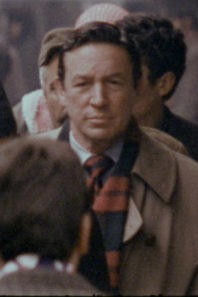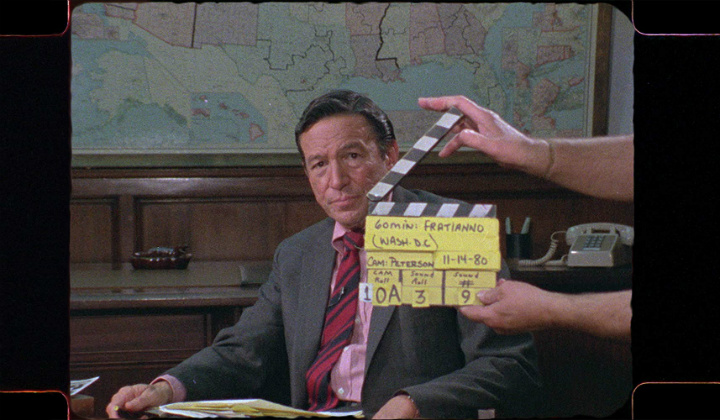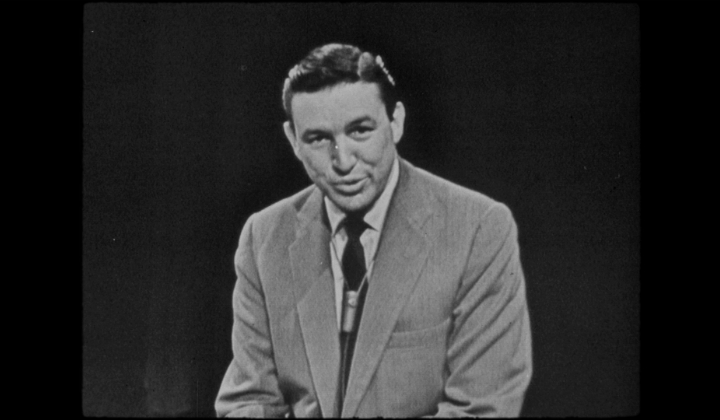
Director Avi Belkin doesn’t waste any time getting to the point of his new film, Mike Wallace Is Here. The documentary opens with the titular subject, Mike Wallace, in an interview with former Fox News blowhard Bill O’Reilly.
Wallace, ever the professional, comes off as cool as an arctic breeze, while O’Reilly fusses and howls like a WWE star cutting a Wrestlemania promo. No one with any sense buys O’Reilly’s theatrics. But his bombastic cry for attention is the cost of doing business in today’s crowded media landscape. The times they are a changin’, and so are the standards for what America considers acceptable journalism.
Belkin’s documentary Mike Wallace Is Here paints a no-nonsense portrait of one of America’s journalistic heavy-weights – a guy deserving of a spot on the TV journalism Mount Rushmore. Wallace is the perfect subject for a documentary retrospective, and I can only imagine Belkin’s struggles to chop this story down to a svelte 90-minutes (The director sorted through over 1400-hours archival footage).
One of the film’s central themes is Wallace’s struggles with self-doubt. His career took many unconventional twists and turns before his iconic 60 Minutes run. Wallace was a radio personality, TV game show host, and commercial pitchman. So, when he transitioned to journalism, Wallace didn’t have the bona fides of his colleagues.
One of the most fascinating parts of the movie is how his self-doubts – which hounded him his entire life – affected his journalism career. Wallace’s dogged line of questioning exposed his subject’s secrets, while also revealing his insecurities. Although this self-assured, thoughtful, and hard-hitting journalist could size someone up in a single glance, he had trouble defining himself. By getting to the bottom of an interviewee’s story, Wallace learned things about himself.
Belkin’s film consists entirely of archival footage. He skips the standard interview subject pool of family, friends, and cultural critics and opts to rely on old interviews which spanned Wallace’s 70-year career. This approach works well since Wallace spent so much time on camera, as both the interviewer and the interviewee.
Belkin masterfully splices together footage from old and recent interviews to map out society’s shifting standards towards journalism. We can practically see the bar lowering as we speed towards the fake news era. But the way he highlights the double standard of Wallace’s interview tactics takes the cake. We watch Wallace take great offence to certain questions as he’s interviewed – going so far as to call them dumb – even though the doc shows him asking the same questions to his interview subjects.
Towards the end of the film, Belkin peels back enough layers to reveal a depressed and suicidal man who questioned his legitimacy. But this film is about the work, and much of Wallace’s personal life gets left on the backburner.
People referred to Wallace as an “Interviewer, journalist, and a killer,” and based on what we see in this doc, nobody will disagree. Wallace employed an abrasive style that was ahead of its time, and he wasn’t afraid to ask anyone uncomfortable questions. Whoever sat down in the chair across from him for an interview was fair game. Whether you were a rock star, politician, mobster, soldier, or a prince, he didn’t hold back the tough questions.
The film does an excellent job showing us what made Wallace great as well as how he changed the industry. Nothing gets Wallace’s caustic needling across like Barbra Streisand calling him a son of a bitch. And nothing conveys his journalistic integrity like calling out ruthless world leaders such as Vladimir Putin while sitting face-to-face. Wallace never backed down from bullies and always put his money where his mouth is.
Watching Wallace go hard at his interview subjects is riveting, especially when set against John Piscitello’s pulsing score. Belkin jazzes up the film’s look by framing the action within old-timey-looking broadcast airwave signals and giving some shots a vintage look. Editor Billy McMillin cuts the film brilliantly, often splicing the footage into two side-by-side panels. He stitches decades worth of old interviews together in a way that flows naturally and imbues the doc with a coherent narrative arc.
Mike Wallace became a TV news icon, but deep down he never shook his gameshow host origins. People accused him of dramatizing news and being a performer, which is a cutting insult to a guy who started off doing radio shows and schilling products on TV. The irony is that Wallace is a saint by today’s bonkers standards.
Being a performer is essential to making it on TV in 2019; today everyone does a song and dance to get noticed. Wallace was the type of dogged reporter we could use right now to cut through all the bullshit in our current news cycles. Wallace’s professionalism, conviction, and integrity separate him from today’s crop of news flunkies. Today, people working in media seek to pimp their brands, get social media likes, and go viral. Wallace’s role was to speak truth to power, and it came at the expense of being liked. And by the end of Mike Wallace Is Here, you get that he wouldn’t have it any other way.
- Release Date: 8/09/2019



